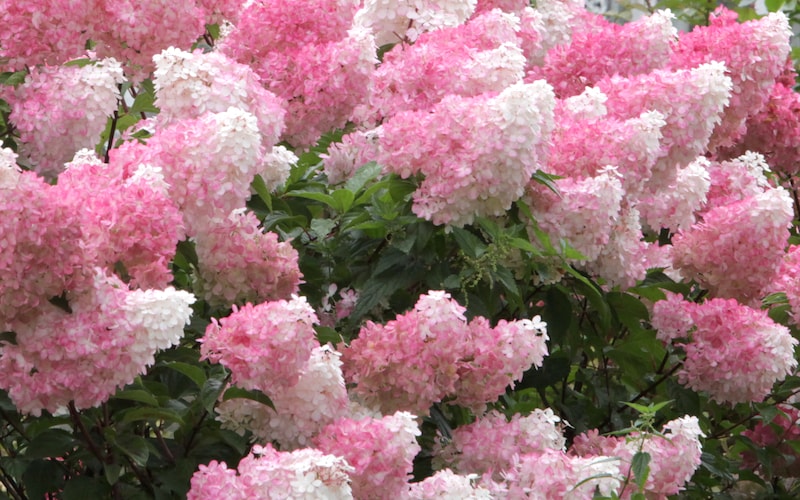For the best advice on selecting, growing and caring for shrubs, we turned to some of our favourite bloggers, YouTubers, and Instagrammers from the horticultural community. These gardeners share insights gathered through years of growing all your favourite shrubs. You might even discover some interesting new varieties you haven’t come across before.
Contents:
- Best advice on using shrubs for structure
- Best advice on low-maintenance shrubs
- Best advice on caring for shrubs
- Best varieties of shrubs to plant
Best advice on using shrubs for structure
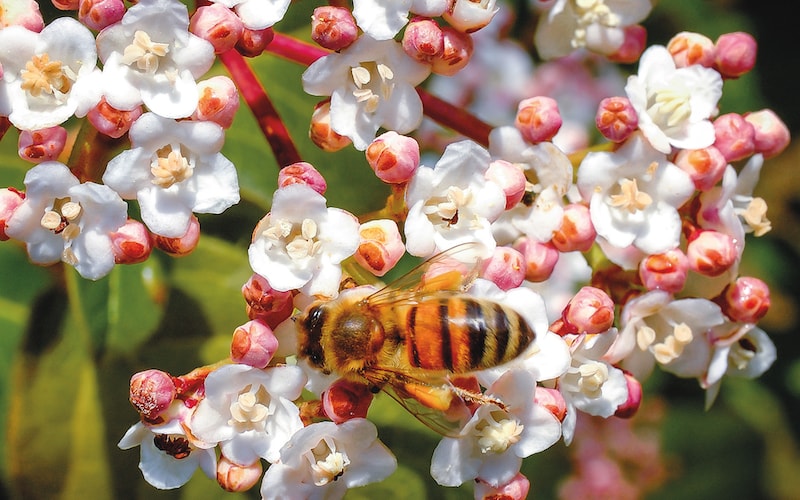
Image: Viburnum tinus from Suttons
Shrubs are the backbone of your garden borders, says Carol at The Sunday Gardener: “A good rule of thumb is to have 1/3 evergreen to 2/3 deciduous, and it often seems…that the best flowering shrubs are deciduous.” Planting shrubs for security or privacy? Carol’s excellent advice is to simply increase the proportion of evergreens to create denser screening.
Plant shrubs as a “foil for more showy plants like summer-flowering perennials,” says Pete at Real Men Sow. Alternatively, he suggests growing them as show pieces in themselves. As he points out, many shrubs flower, some have beautiful autumn colours, while others offer wonderful variegated foliage bringing splashes of gold, yellow and even purple to your planting scheme. Read Pete’s full article, especially if you’re after suggestions for shade loving varieties.
Creating beautiful borders is all about learning how to layer your planting, says Lee Burkill at The Garden Ninja. Head over to his blog where you’ll find lots of great information on how to plant up your borders with groundcover, a herbaceous midlayer, and at the back, taller grasses and shrubs. He says the second layer is where lots of gardeners stop, but your shrubs and grasses should be “where all the drama and action happens!”
If it’s formal structure you’re looking for, topiary shrubs could be an attractive option. Alexandra at The Middle-Sized Garden explains that topiary is an excellent way to provide shape and structure, especially in the winter. Many associate topiary with box which, here in the UK, has suffered greatly from box blight and box tree caterpillar, but, says Alexandra, lots of other shrubs can be clipped into shape. Join her at a stunning private garden in Kent as she interviews head gardener Jim Treby about the best shrubs for simple topiary.
Best advice on low-maintenance shrubs
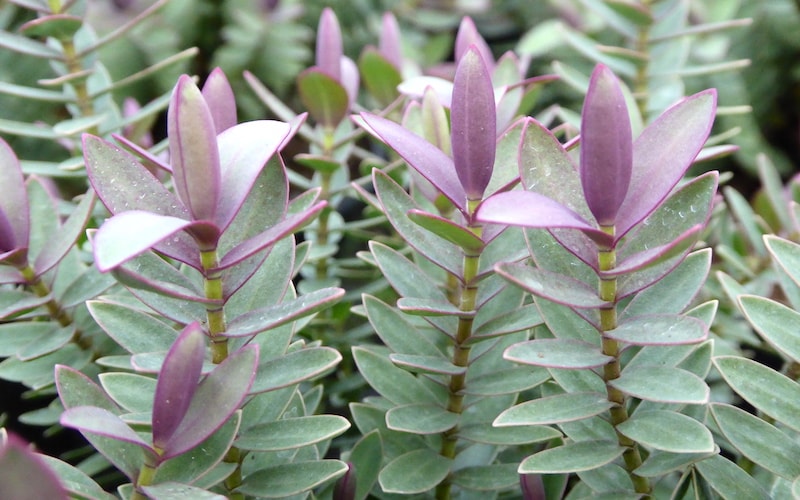
Image: Hebe ‘Red Edge’ from Suttons
Over at Buckinghamshire Landscape Gardeners, Paul Nicolaides says a common mistake is to plant shrubs which are too big and prolific: “This results in continuous cutting and trimming throughout the season. Consequently, borders become filled with a series of large, clipped rectangles which shade everything else out.” If you’d like some info on plants that maintain their form without growing out of control, Paul has some great suggestions.
At Growing Family, Catherine shares a good idea to reduce the time you spend tending to shrubs. She says planting lots of one type of shrub provides high visual impact and means you can prune them all at once, saving you precious time in the process. Looking for recommendations for low maintenance shrubs? Catherine says, “heather and lavender look and smell amazing and, by and large, will take care of themselves…”
Plant shrubs as a vital part of your wildlife garden and, not only could you save on maintenance by letting nature take its course a little more, but you’ll attract a wide range of birds, mammals and insects to your patch too. Take a look at the Wildlife Trusts’ article on how to make a shrub garden for wildlife for some excellent seasonal planting ideas. Try currant for spring, hebe for summer, St John’s wort for autumn, and witch hazel for winter.
Best advice on caring for shrubs
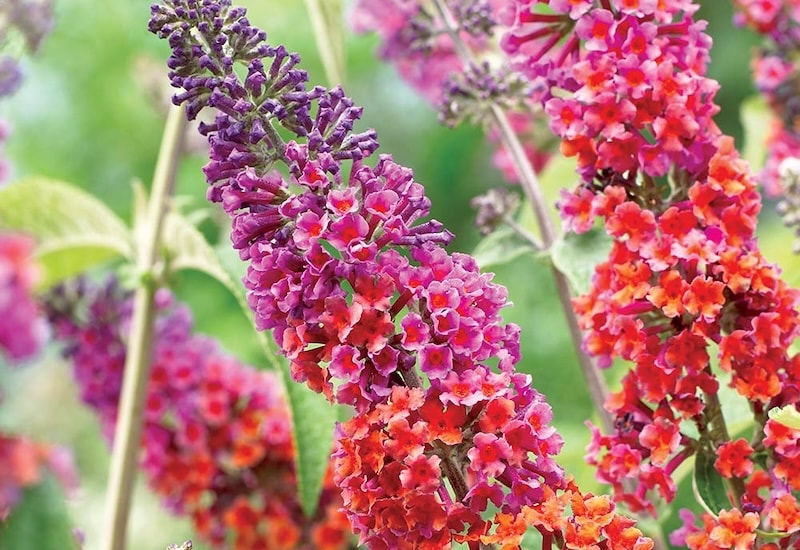
Image: Suttons
Before we had plastic pots, autumn and winter were the best time for planting new shrubs because bare root and “dormant perennials, shrubs and trees could be dug up, wrapped in hessian and sent to the grower without fear of the plant being shocked,” says Katherine Woods from the Tea Break Gardener. Autumn and winter are still the best times to plant shrubs, says Katherine, but winter planting is all about planning rather than impulse buying, because you have to imagine the end result.
Many buddlejas are hardy survivors but, like any plants, they can suffer from pests and diseases. Instagrammer Dawn from @dawns_gardening offers a top tip to cure a fungal disease she used when her Viburnum davidii developed an awful leaf spot. Her method? “In spring I removed all leaves showing signs of disease, I gave it a light prune then sprayed with a mix of 10 parts water to 1 part milk…” See her post for the full method.
Best advice on pruning shrubs
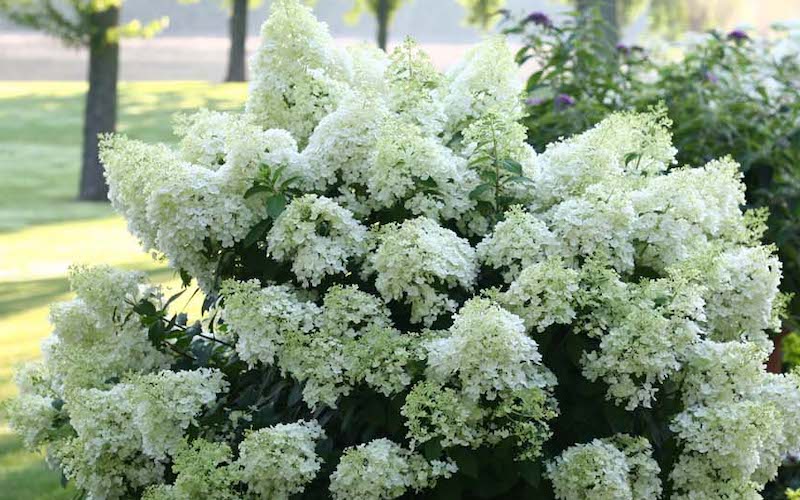
Image: Hydrangea paniculata ‘Bobo®’ from Suttons
There’s a real temptation to give everything a good tidy up with the pruning shears in spring, but don’t cut back any spring-flowering shrubs until after they’ve finished blooming or you won’t get any flowers, says Carol at The Sunday Gardener. Lots of lovely shrubs like spiraea and philadelphus are just getting ready to delight at this time of year. If you’re not quite sure what to prune in April, take a look at Carol’s video guide.
If you’re in a hurry to get out there with your shears and start pruning, watch Lee Burkhill’s 60-second pruning guide over at Garden Ninja. Lee takes you through all the main elements of successful pruning in less than the time it takes to remember where you put your secateurs.
For a demonstration of how to prune buddleja, watch this video from Horti Couture. The gardener says it’s last year’s growth that you want to cut into, and that you should always prune just above a pair of buds. He goes for the second pair up from the base because if one pair fails, there’s another to take its place.
Box getting out of hand? Over at Horti Couture, there’s a great video on basic box pruning to help you reign in your unruly shrubs. Watch as this master pruner gets to work with his shears to create domes and straight lines. His top topiary tip: cover the ground at the base of your hedge with empty compost bags. This makes it easier to collect the clippings and also reduces the risk of spreading disease. He also offers an excellent guide to pruning dogwoods if you’re looking for tips to make the most of their wonderful red winter stems.
If you’ve recently moved house and inherited shrubs, it’s likely you’ll have a hydrangea that needs rejuvenating. Join Nick at UKGardening as he demonstrates how to prune mop-head hydrangeas. He renovates unruly shrubs by pruning out a third of the old growth each year for three years.
Best varieties of shrubs to plant
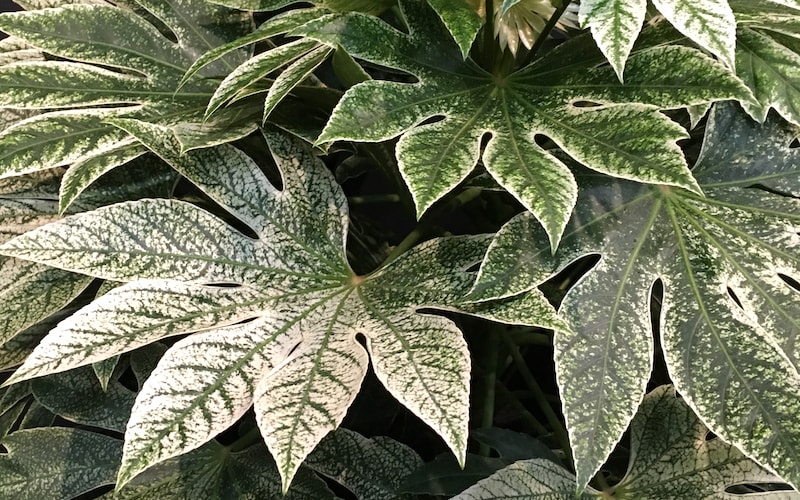
Image: Fatsia japonica ‘Spider’s Web’ from Suttons
If you’re on the lookout for the kind of shrubs that can withstand drought conditions, Carol at The Sunday Gardener suggests ceanothus, cistus (rock rose), and rosemary. A quick visit to her site reveals yet more top plants and shrubs for dry soil. As Carol says, “drought-resistant plants and shrubs are amongst some of the most colourful and attractive garden plants, and there are lots to choose from.”
You don’t need a big garden to grow shrubs. In fact, as John Moore at Pyracantha says, “there are some wonderful evergreen and deciduous shrubs that you can incorporate into your small garden.” Just one of his favourite 10 evergreen shrubs for small gardens, Pieris ‘Forest Flame’ is an excellent example of how to bring “a luminescent quality and rich design to your space.”
For winter colour, Dawn from @dawns_gardening posts some wonderful images that show just how vibrant winter shrubs can be. Check out the gorgeous combination of “Choisya ternata ‘Sundance’ and cotinus lighting up the November garden.” Cotinus also looks fantastic planted alongside Cornus alba ‘ Sibirica’ and Euonymus fortunei ‘Emerald ‘n’ Gold’. The effects here are just stunning.
If you’re looking for a wildlife-friendly shrub that provides all year round interest, Viburnum tinus is a lovely winter shrub, says Sarah Fry at @thegardentamers. The vibrant white flowers provide pollen late into the season and are followed by unusual blue fruits.
For gardeners whose efforts to grow evergreen shrubs are limited by lack of sunlight, Barney Davidson at The Jolly Gardener offers his recommendations for “faster-growing evergreen shrubs suitable for full & partial shade”. Viburnum, Oregon grape, and Japanese aralia all feature among his top choices. Head over to Barney’s blog where this pro gardener with 20 years of experience offers advice on the right shrubs for your plot.
We hope our pick of some of the best online content offering advice on growing shrubs enhances your gardening confidence. For more help and advice on sowing, planting, and growing, please head over to our Growing Guides, where you’ll find a wealth of helpful information.
Lead image: Hydrangea pan. ‘Vanille-Fraise’® from Suttons
Last Updated on November 8, 2024 by Suttons Horticultural Team

